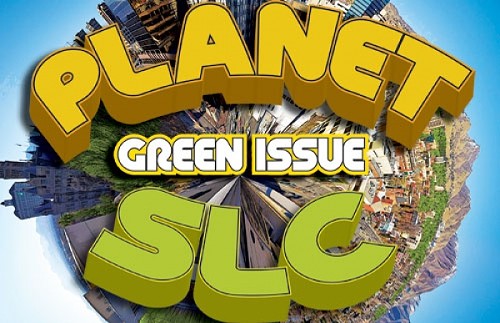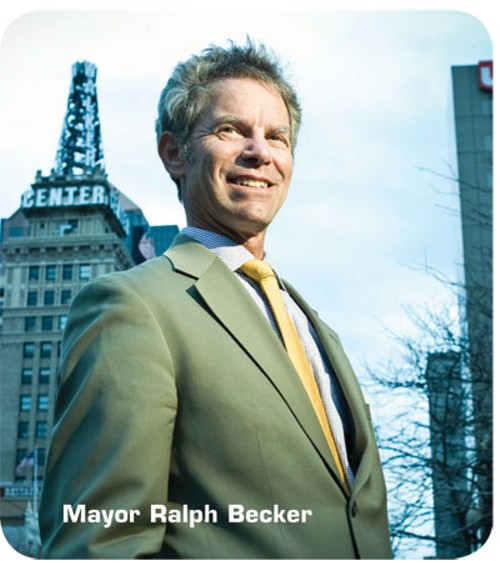Becker: Finding the Green Connection
The mayor's quiet policy-making has turned his eco-friendly dreams into reality
By Rebecca WalshEarly in his first year in office, Salt Lake City Mayor Ralph Becker got a lesson in environmental gamesmanship from his predecessor—and polar opposite—Rocky Anderson.
The city was looking for a new home for the cop shop. Becker had suggested the eastern edge of the Salt Lake City Main Library block. And Anderson, who, eight years earlier, scrapped former Mayor Deedee Corradini’s plans to put housing and shops on that land, figured Becker’s idea would muddle his legacy. So, he called out the TV cameras.
Burned by Anderson’s blitz, Becker backed off and moved the police headquarters one block farther east.
He might have lost the rhetorical battle, but in the end, the quieter, gentler mayor may still win the green cred: Salt Lake City will replace the 50-year-old, crumbling police tower at 315 E. 200 South with a modern, airy, $125 million building slated to open in 2013. With a solar canopy and green roof, the headquarters will be “net zero” under the architectural guidelines for green building known as LEED (Leadership in Energy & Environmental Design), generating as much energy as it uses.
It’s process over puffery. Less sexy, more solid.
Observers of Becker’s four years in office* say despite a few notable missteps, Salt Lake City’s mayor is establishing an environmental résumé longer and more lasting than that of former City Hall residents.
More importantly, grass-roots greenies say, he walks the walk—driving a diesel Jeep, biking all over town—and not just for the publicity.
“He’s a low-impact person,” says Cherise Udell, founder and president of Utah Moms for Clean Air. “His footprint is small.”
Four years ago, Becker presented the city with a “blueprint” that included, among other things, teaching Salt Lake students a second language, establishing domestic partnerships and building a Broadway-worthy theater.
The new mayor also left green footprints all over his plan. In many cases, Becker’s to-do list carried on where other mayors left off: completing the Jordan River Parkway through the city, funding TRAX trains, creating more electric-vehicle charging stations.
More apparatchik than revolutionary, Salt Lake’s mayor approached the job like the policy wonk he is. His ideas for city neighborhoods are a new urban utopia: He wants every neighborhood to have its own commercial center, locally grown food, bike paths, a natural-gas filling station. He’s still working on a gray-water recycling program and a system of incentives to encourage Salt Lakers to get rid of their gas-powered lawn mowers.
“It’s not a matter of doing just one thing,” Becker says. “It’s a matter of looking at all the elements separately and putting all of them together to make a complete agenda.”
Not all residents approve. “Mayor Becker is obsessed with bike lanes,” Bill Breckinridge wrote in a letter to the editor in The Salt Lake Tribune in February. He urged his neighbors to fight Becker’s plans for a bike lane on Sunnyside Avenue. And they did.
So, the mayor has had to slow his plans to narrow Sunnyside. Sometimes, his is a plodding crusade.
Outside of City Hall’s ivory towers, Becker has bumped up against more opposition: in his handling of the Chevron oil spill, his own anti-idling ordinance and a proposed gondola linking the Canyons and Solitude ski resorts.
Becker was front and center when the oil pipeline burst in Red Butte Canyon, spewing 55,000 gallons of raw crude into the creek and Liberty Park’s pond in June and December of 2010. While Gov. Gary Herbert and the State Department of Environmental Quality hemmed and hawed, Becker met repeatedly with the oil refiner. In 2011, he settled the city’s claim with Chevron for $4.5 million.
Some residents think he was too soft on big oil, too cozy. From the moment Becker stood up at a community meeting right after the first spill and uttered the words “thank you” and “Chevron” in the same sentence, Utah Rivers Council Director Zach Frankel says, residents’ concerns have been overlooked. The city’s settlement does not include mitigation funds for homeowners’ property or a health-monitoring account to track the illnesses of those sickened by the fumes and sludge.
“It’s so conservative,” Frankel says. “If the mayor’s going to step in front of the cameras, he needs to be tough.”
Becker insists nothing he agreed to blocks future health or property-damage claims.
“We feel we were compensated fairly,” he adds. “We’re advocating on behalf of our residents and making sure their voices are heard.”
Red Butte neighbors have sued, but limited their claims to property damage. Their lawyers have told them not to talk while the court battle progresses.
Dr. Brian Moench, president of Utah Physicians for a Healthy Environment, says a health-monitoring study would take years and dozens of participants. It’s much harder for individual city residents to litigate future health problems.
“It’s certainly late to try that now,” Moench says. “The window of opportunity for making it meaningful is rapidly closing.”
Another controversy ate up the mayor’s time during the 2012 Legislature.
A year ago, Becker took up the cause of Utah Moms for Clean Air. And in fall 2011, the City Council passed an ordinance making it illegal to sit idling in your car for more than two minutes. Violators face fines between $50 and $210.
“He’s not a statement mayor,” Udell says. “He was doing it because it was what’s right for city residents.”
But such crunchy granola stuff provided itchy state lawmakers the excuse they needed to smack down the liberal capital city—again.
West Jordan Republican Rep. Wayne Harper wrapped himself in the Constitution to protect Utahns’ private-property rights. “Sometimes cities go through and step beyond the bounds,” he told KSL.
So Becker had to fight for it—in his way. Reprising a role he played for a decade in the Utah House, Becker was the beleaguered Salt Lake City liberal to the Capitol’s fire-breathing conservatives. And it worked: Where Anderson’s rhetoric once might have ended in conflagration, Becker’s mild glad-handing resulted in a compromise. Lawmakers carved out exemptions for private-property owners, and Salt Lake City got to keep the rest of its ordinance.
“He was there for us—110 percent,” Udell says.
Now, Becker has plunged into the debate over the so-called SkiLink. And his job—protecting the city’s vast canyon drinking water supply—pits him against every Republican member of Utah’s congressional delegation.
Sens. Orrin Hatch and Mike Lee and Reps. Rob Bishop and Jason Chaffetz have all signed on to legislation requiring the U.S. Forest Service to sell 30 acres of public land to Talisker, the Canadian owner of Canyons Resort, and clear a path for the mountain-topping people-mover. At the same time, Becker backs Democratic Congressman Jim Matheson’s efforts to designate another 30,000 acres of national forest land as protected wilderness.
Every mayor before Becker has had the same task. But, Save Our Canyons President Gale Dick says, Becker is more dedicated than most.
“He really feels strongly about the possible loss of public access,” Dick says. “Ralph is much more dedicated to it than Rocky ever was.”Â
Rebecca Walsh is a longtime Utah reporter and columnist. She is currently working in Palm Springs, Calif.
*This story has been corrected from the version that appeared in print, which misstated the number of years Becker has been in office.
More by Rebecca Walsh
-
Block the Vote
Conservatives try to make voting a privilege
- Oct 24, 2012
-
Creating a Martyr
KSL should've just let The New Normal get canceled
- Oct 3, 2012
-
Rich Mitt
Romney-Reid scuffle highlights Mormon's uncomfortable relationship with wealth
- Aug 29, 2012
- More »










